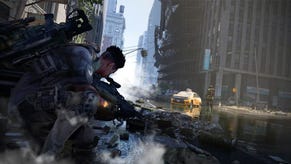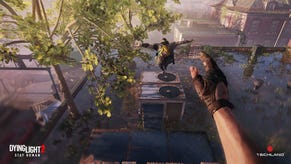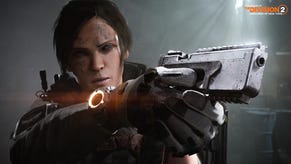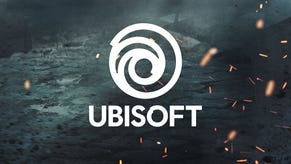A Day With The Division 2's PvE: The Brutal New Endgame Faction and What's Next After Launch
With nearly six hours of demo time, we explore The Division 2's PvE approach with insight from its creative director and lead designer.
This article first appeared on USgamer, a partner publication of VG247. Some content, such as this article, has been migrated to VG247 for posterity after USgamer's closure - but it has not been edited or further vetted by the VG247 team.
I've only been to Washington D.C. once, and I'll be honest, I barely remember it. From what I'm told by people behind The Division 2 though, its video game rendering of the city is a 1-to-1 recreation of the capital of the United States. Only here, it's in ruin. Our Base of Operations is in the literal White House for crying out loud, with no president to be found. I even briefly looked around the safe space hub searching for the Oval Office in my demo, but I couldn't find it.
Last week, I played about six hours of The Division 2's PvE content on PC, but it felt like a lot more. The event was held in a gorgeous former bank, and there was a bizarre photo booth opportunity for press and other attendees to pose with fake guns in front of an American flag. (Yikes.) We got a taste of the open-world and story missions, and then after a short break dove into its endgame—where the real meat of this always-online game is.
Where its predecessor felt sparse at launch, Massive Entertainment's plan with The Division 2 is to bring forward the hard lessons learned. That means its first year of content will be free, not paid DLC like the original, providing a healthy amount of stuff to do for the players who power through the core story and are left wanting more.
"It was kind of a shame that the living world in the last game—once you cleared it out, found all the collectibles, and did all the side missions—there wasn't a lot there for you to uncover and you mostly fast traveled," Keith Evans, lead designer on The Division 2, tells USG. "This time I really think a lot of players are going to walk between missions and walk between their experiences because that living world is constantly going to be feeding them new, really replayable gameplay. So I think that's kind of the thing that players won't be able to really understand until they feel it."
The appeal of The Division 2 is easy to discern. In a world where most shared world loot shooters are always rooted in space or some other fantasy, The Division 2 brings it to a more grounded realm: a post-apocalypse. Only there are no zombies. (Thank god.)
Citizens Come First
The Division 2 is changing locales quite dramatically, moving from the cold winter of New York City to sunny Washington D.C. "This is a Tom Clancy game and Tom Clancy games have always been about geopolitics. Well, you know, it's still a piece of entertainment," creative director Julian Gerighty tells me about D.C. being a bit of a loaded location considering the state of our country. (Something that Ubisoft's marketing seems cognizant of.) "[We thought] Washington D.C. could be a super interesting city to explore, especially when you consider all of the safeguards that are in place to stop a pandemic from creating this sort of complete collapse. So the fantasy of a collapse and this incredibly well-armed city collapsing, that was something that we wanted to investigate."
Gerighty points to a focus on D.C.'s citizens as a primary driver of the overall narrative, from main quests (like a mission I played to rescue a settlement leader's daughter) to the smaller audio log-like Echoes you find across the world, where a pre-collapse scene plays out in a hologram laid on top of the destructed in-game setting. "The rebuilding of the country is going to go through civilians," says Gerighty. "So what are their stories? What are the stories that we could investigate there that could be super interesting? So you have a macro, super bombastic save the city [plot], but at the end of the day there's somebody who needs to get some fresh water or find some medicine for their kids, that type of thing."
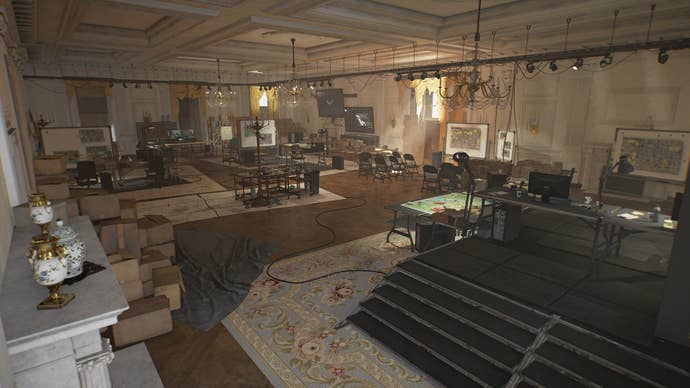
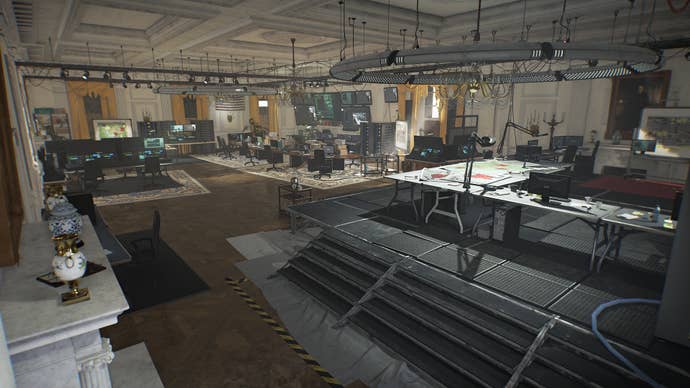
The warmer climate of the new open-world will also extend to the character customization: specifically in the cosmetic gear you can land for your character. In The Division, some complaints were centered around its samey characters, from the character building itself to the repetitive bundled up outfits they would don. Luckily, that complaint did not go unheard. From its new backpack trophy system—basically The Division 2's version of shoulderpads from World of Warcraft—to a robust "RPG-style" character creator, character customization is promised to be better in the sequel.
"Our goal this time is to look at all the things we added in post-launch [in The Division]. We've had a very, very, very open conversation with the community going forever on this game. So we were able to look at what things resonated the most with them and bring them over," says Evans. Things like World Tiers, challenging missions like "Invaded" quests, and the brutal Occupied Dark Zones are available right from launch for players.
"We're trying to cater to a pretty wide base of players and pull lots of people along with us into the endgame and all the post-launch content that's going to be free. But, you know, very specifically give them new challenges that's different from the main game, and a clear goal. That's the main thing. We gave players in the first game a goal to strive towards and enough content that they can do a different thing every day of the week. That's when it really clicked and the community got really happy. So I think we have that this time at launch, and it's only going to get bigger."
The Endgame
Developing a strong endgame is a tricky thing. Most games have figured it out the hard way, with Destiny, Warframe, Rainbow Six Siege, and many others floundering at launch with large player drop-offs, slowly building up their content in the months (even years) after. The Division was one of many games cast with what I'll call "Destiny syndrome." But Ubisoft persevered, as it does with many of its online-focused games. Eventually, The Division wasn't only worth picking up again, but it's been a continually rewarding experience for its core playerbase too.
"We shipped the first game. We had this 30-hour campaign that we had all worked super hard on and we're like, 'We did it!' And then people go through that content super fast," says Evans, "and they're immediately like 'what's next?' We knew when we shipped that we wanted to fill in the gaps and make it more robust, and we kind of did that, but it took two years for it to really solidify into a thing. And now people who play the game at first who jump in, it's like a transformed, totally different game."
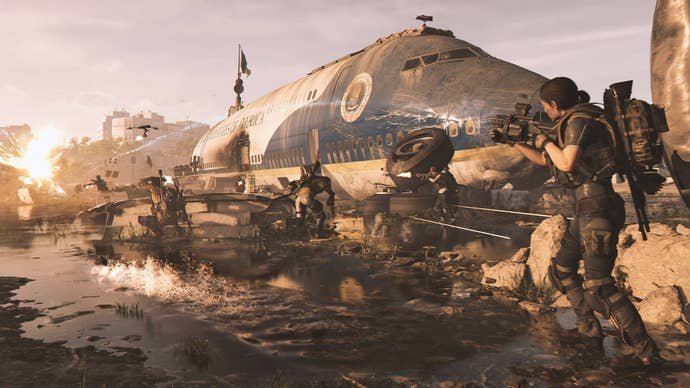
At endgame, a whole new enemy type—the Black Tusks faction—will slither its way into the open-world, migrating from stronghold to stronghold as an omnipresent challenge for players. (That's in addition to the three Dark Zones, of course.) Their encounter style is modeled after a spec ops team, meaning they're a lot more coordinated than your average faction.
"This game is much more lethal than the first game. Cover matters so much more than in the first game. Tactics matter even more [than] in the first game," says Evans. "Endgame just kind of starts feeling like this continuation of the first story. You hit endgame, and [the Black Tusks] move in, their invasion starts and you have this very clear goal. Invade a set of missions and a stronghold, and you have to power up enough to push them out and then they move somewhere else in the world. It has this tempo and pace and this clear goal of 'okay, that's what I'm grinding for, that's what I want to do.' And at the very end of that whole thing is the raid."
While Evans is remiss to detail the raid yet, as it comes at the end of the campaign and Black Tusk-centered content, he is quick to assure that it's not just a bloated Incursion—the hardest PvE content of the last game. "It's a true raid and it's what people are expecting. You know there's raid mechanics, there's mysteries for you to uncover. There's bosses for you to take down and it's really a different type of PvE than the rest of the game," he says.
The two missions we were sent through in the endgame demo were quite rough. Both in difficulty—a welcome change that required a lot of communication and working together within my team—but also in overall quality (similar to the first half of our demo). Nearly every step along the way of both demos, we hit a road bump. Doors wouldn't open for our team to progress and a developer would have to step in to get us through repeatedly; I couldn't complete a key story mission because the end cutscene wouldn't initiate even after hitting the "talk to this person" prompt repeatedly (instead of seeing it through, I was urged to just explore more of the open-world). Sometimes enemies would hitch in doorways, crowding up entry closets. Of course, demo bugs are normal, and it's essential to take even the most glaring problems with a dose of "s**t happens" mindfulness, but how prolific the ones I experienced were made it harder to look past.
The Future of The Division 2: Post-Launch
The Division is one of Ubisoft's big surprise successes over the past few years, joining the likes of Rainbow Six Siege, Ghost Recon Wildlands, and other games the company has stuck by in the long term, amending the faults of their launches. The Division 2 is blazing a new direction though, one hopefully not cursed at launch like its predecessor.
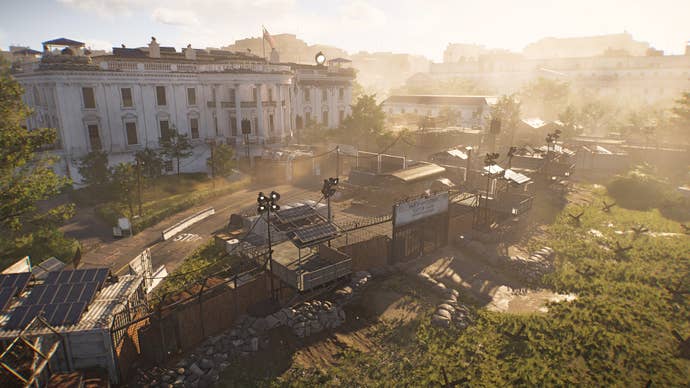
"We basically learned in the launch of the first game that people really liked a lot of the DLCs we did, but every time we released one as a paid DLC, it just fractured the community," says Evans. "So in Year Two, we made a commitment that all the gameplay drops were going to be free and it actually like revitalized the game, brought players in, and made the community super happy. So we want to do that throughout this whole first-year content. Make everything free, and just constantly be giving players new things to do so. I think that's kind of our strategy."
Year One of The Division 2 has big plans already, as outlined at the event. New eight-player raids will be introduced, in addition to three episodes and three additional specializations. Specializations, in particular, are a new addition, whereupon reaching level 30 in the base game, players will be able to choose from a number of specializations that outfit you with a unique, powerful weapon. In my time with the endgame content, I was a Survivalist, leaning heavily toward support (including a handy little mine that would heal people on my squad that I directed it to follow). The Survivalist has a crossbow as their special weapon. Post-launch, more Specializations beyond the starting three will be introduced.
Despite an often frustrating demo experience, The Division 2 is at least hellbent on forging a strong start for a sequel in prioritizing its endgame content—something sadly unheard of for the launch of most online-driven games. Whether that renewed sense of purpose will pay off for core players remains to be seen, but in the meantime, The Division 2's private beta kicks off on February 7, and lasts until February 10. The Division 2 launches on PlayStation 4, Xbox One, and PC on March 15.



